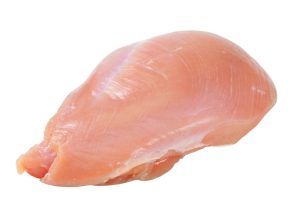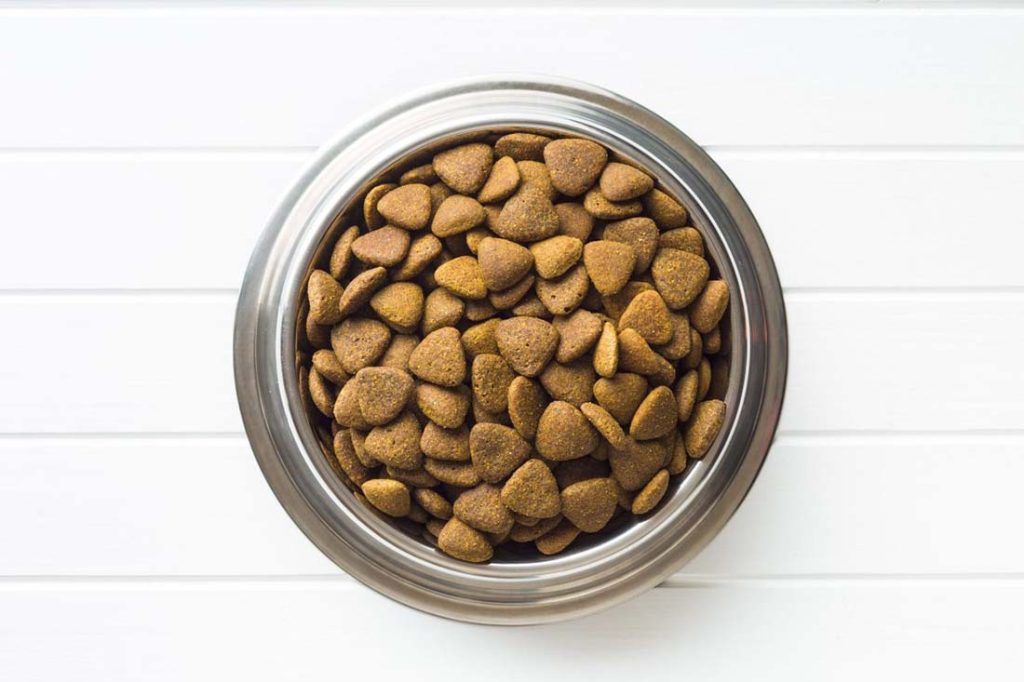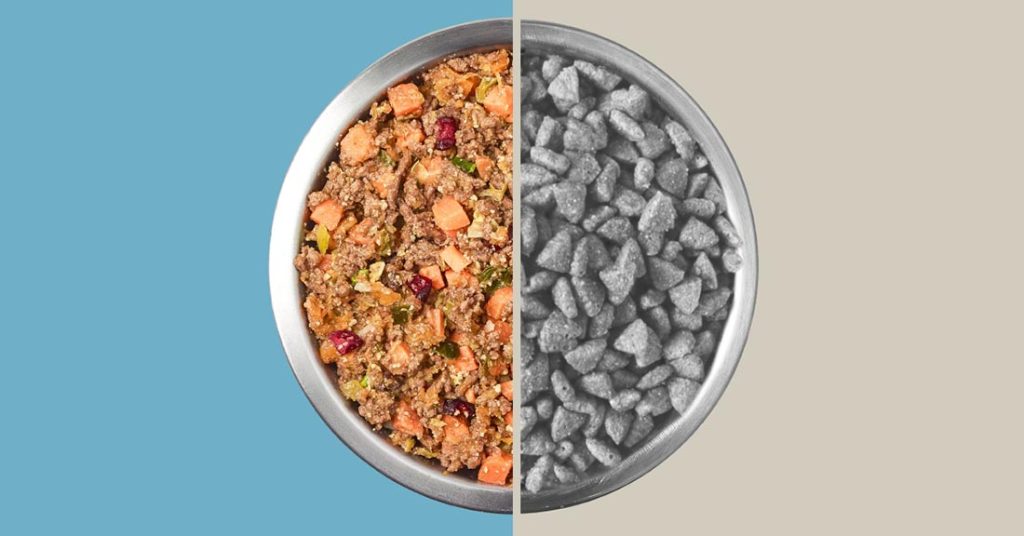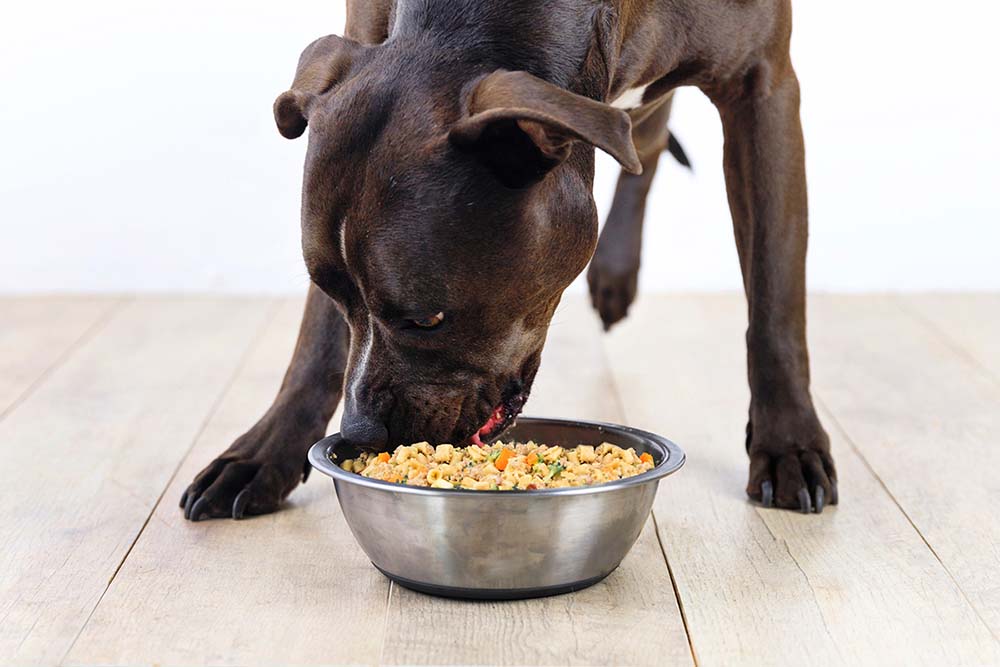There are a LOT of pet food choices out there. I mean, your local pet food emporium probably has upwards of 100 different brands. From kibble to fresh, you might find yourself wading through dozens of pet food labels trying to ferret out the best choice for your pup.
Of course, you want high-quality nutrition for your pet’s health and well-being. But so many commercial pet foods are filled with a laundry list of unfamiliar ingredients, including chicken meal.
In fact, chicken meal or other meat meals shows up so frequently in pet food you might wonder where chicken meal comes from. What parts of the chicken comprise chicken meal, why is it in so many pet foods, and is it good for your pet?
Great questions.
To answer, it’s let’s start by defining the difference between chicken and chicken meal.
What’s the Difference Between Chicken and Chicken Meal?

According to the Association of American Feed Control Officials (AAFCO), if chicken is listed as one of the first ingredients on the dog food label, the food contains fresh meat you’d recognize. As in raw chicken breasts you might make for dinner.
However, because raw chicken flesh has so much water in it, you have to use a lot of it to get enough protein into a bag of dog food. But what happens if you overcook the fresh meat? It drys out, right? That drying process is similar to the first step in turning chicken into chicken meal.
Chicken meal is essentially dried-out chicken meat ground into a powder.
Imagine a pile of fresh chicken. It’s put into a rendering machine that applies high temperatures and pressure to the chicken during the cooking process. It squeezes out the water and fat, leaving behind protein and minerals. Rendered products are called “meal” because the chicken is ground into a powder.
But let’s back up and consider the poultry industry.
The poultry industry has a category called “clean chicken.” This means it has no feathers, feet, or intestines. Chicken meal is made from clean chicken. However, chicken meal can include parts from so-called 4D meats. Those D’s stand for dead, dying, diseased, or disabled.
As you can imagine, that can offer a mixed quality of chicken flesh, including potentially high levels of pharmaceutical drugs in those 4D meats.
As a pet parent, you probably want to know what you’re feeding your dog.
Unfortunately, pet food manufacturers don’t rate the quality of their ingredients. Commercial pet food may include chicken filets fit for human consumption or bits and pieces from the chicken carcass. There could be a mix of 4D meats. These 4D meats can be safe for your dog to eat, but they may not be very nutritious.
Plus, the high temperatures used in the cooking process strip the nutrition from food. Just like for people, minimal cooking of whole foods benefits your dog’s digestion most.
Why Do Pet Food Manufacturers Include Chicken Meal?

There are two primary reasons why so many dog food companies use chicken meal: cost and shelf life.
- Cost. Chicken meal is a cheaper food ingredient than whole chicken. Premium pet foods often include higher-quality fresh chicken with chicken meal as a backup. Lower-tier pet foods usually have less chicken meal if any, as they use cheaper ingredients like corn as the base ingredient.
- Shelf-life. Dry dog food can last for months on the shelf with rendered products like chicken meal. Dog food manufacturers need kibble to have an extended shelf life because the process of packaging, shipping, and then sitting on retailer’s shelves takes weeks.
Now that you have more insight into what chicken meal is and why it’s in so many pet foods, you’re more informed when you ask the important question, what do you feed your dog?
How Do You Choose Your Dog’s Food?

The best dog food to feed your dog starts with your dog’s age, size, health, and activity level. For example, puppies require frequent meals with a high protein content to support their growth and energy levels. You can find out more about feeding your puppy on our puppy page. Pregnant or lactating pups require additional fat.
As your dog ages, they may spend more time napping than chasing squirrels. If you have a senior, sedentary dog, they need a diet formulated for them. Many senior dogs benefit from the addition of glucosamine to support their joints.
You don’t have to be a dog food nutritionist, but it helps to understand the basics of pet food labels.
The AFFCO divides pet food labels into the following main categories: “raw” and “rendered” products.
1. “Raw” products
“Raw”: Don’t be confused by the word raw; it actually refers to meat or poultry you’d buy at the supermarket and cook at home. When it comes to pet food, “raw” separates it from rendered products.
However, animal byproducts are still considered “raw.” The AAFCO reports poultry byproducts are “non-rendered clean parts of carcasses of slaughtered poultry, such as heads, feet, and viscera, free from fecal content and foreign matter except in such trace amounts as might occur unavoidably in good factory practice. If the product bears a name descriptive of its kind, it must correspond thereto.”
This means you can have different types of “meals” like chicken, fish, or meat. If it’s species-specific, it’ll say so, for example, “chicken meal” or “salmon meal.” Otherwise, you can assume it’s a mix.
“Rendered” Products
We covered chicken meal above, but the rendering process of using high temperatures to dehydrate a source of protein also applies to meat and fish. If it’s labeled “meat meal,” it can include a combination of meat, including lamb, beef, pigs, or goats. Again, if it’s species-specific, the label will list it. Rendered products have to meet essential nutrient requirements, like a certain amount of calcium.
Both byproducts and rendered products can contain entrails (the animal’s organs.) Yes, they sound gross to many modern pet parents, but they’re traditional food sources for humans and pets in many cultures.
Besides protein, what else is in pet food?
You’ll likely see other essential nutrients and vitamins, vegetables like peas, corn, sweet potatoes, and amino acids. Two common amino acids found in pet food include DL-Methionine and L-Lysine. You’ll find Taurine common in cat food.
Dog food ingredients are categorized by weight. This means the heaviest ingredients are at the beginning of the pet food label. For example, if chicken is the first ingredient, then it refers to real chicken. As you know, fresh chicken has a lot of water weight and therefore cooks down, so part of that weight includes the water pre-cooking. Many dog food brands add chicken meal as another source of protein.
You can review the ingredient list for whole foods vs. animal byproducts and gauge how much of an ingredient is in something by where it appears on the ingredient list. If it’s in the first few ingredients, the food uses more of those ingredients than the ones further down the list.
But interpreting pet food ingredients is only one way to assess pet food for your dog. You can also look for pet foods that undergo feeding trials with high-quality ingredients. That way, you have a team of scientists reporting on the nutrition of the food and how it affects dogs.
You also want to know how well your dog digests the food.
Digestability of Pet Food

Gastrointestinal disorders are some of the most common health problems in dogs. Of course, tummy upsets can be the result of any number of things, including gorging on the contents of an overturned trashcan. Such upsets usually leave evidence of the overturned trash can.
However, if your dog has a case of tummy troubles, it could be food-related. Your dog may have trouble digesting a particular ingredient. One way to make your dog’s food more digestible is to feed your dog minimally processed foods. That way, your dog’s digestive system can break down the food easily.
For example, if you choose a human-grade chicken-based food for your dog, your pup will be able to digest the chicken and essential nutrients. Some dogs need to go grain free, while others thrive on rice, vegetables, and protein. Good nutrition starts from the inside, but you can see it in the quality of their coat, shining eyes, and healthy stool.
Now that you know the difference between fresh chicken, chicken meal, and animal byproducts, you have a sense of the types of pet food that will boost your dog’s health. You can review pet food labels and look for quality ingredients to benefit your dog inside and out. Real chicken is a natural source of protein that’s healthy for dogs. It’s easy to digest when it’s minimally processed, and your dog benefits from the nutrition.
This content is for informational use only and does not replace professional nutrition and/or medical advice, diagnosis, or treatment. It is not a substitute for and should not be relied upon for specific nutrition and/or medical recommendations. Please talk with your veterinarian about any questions or concerns.
